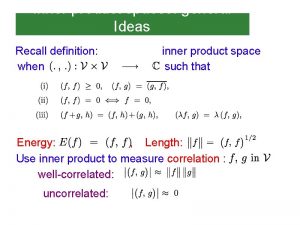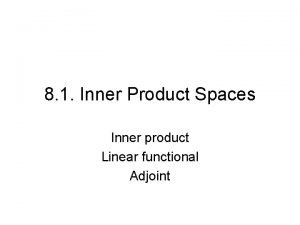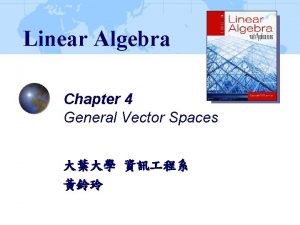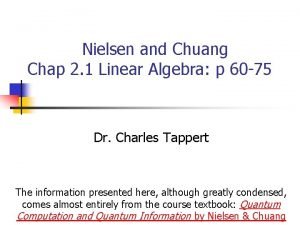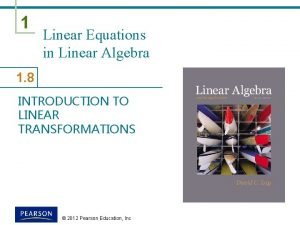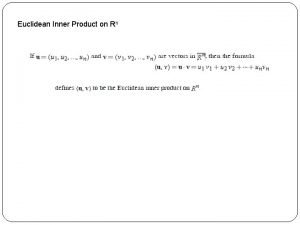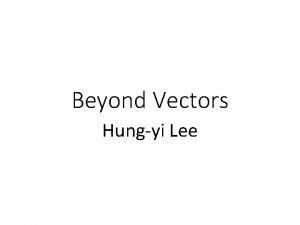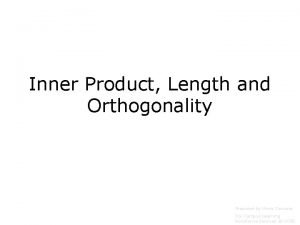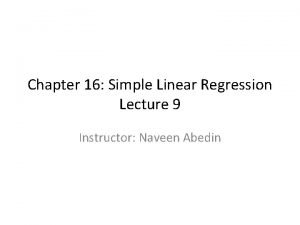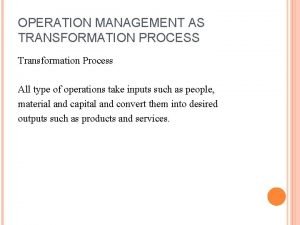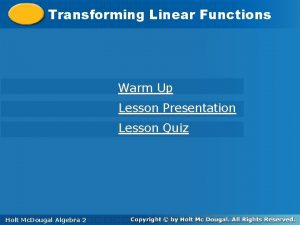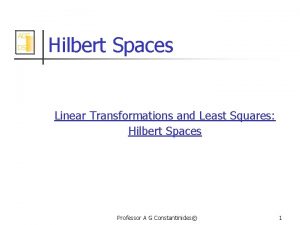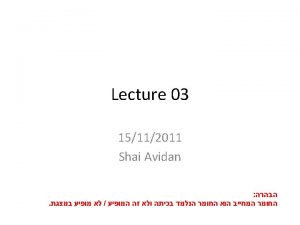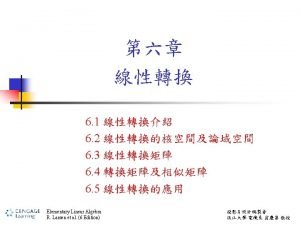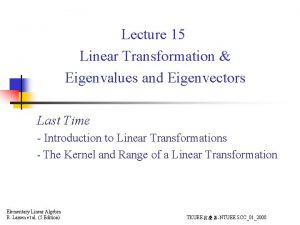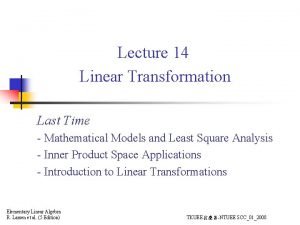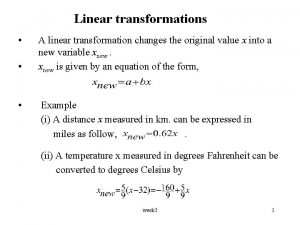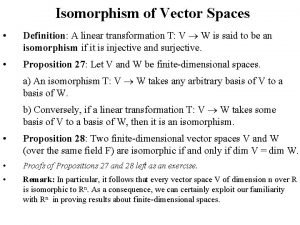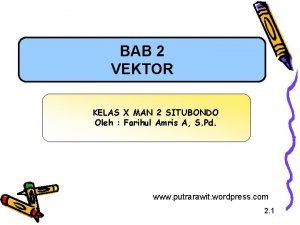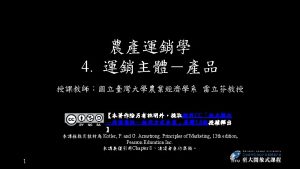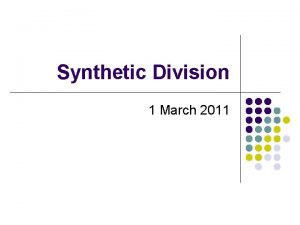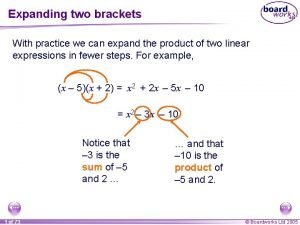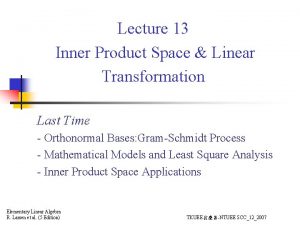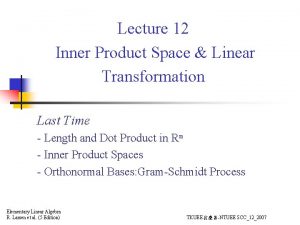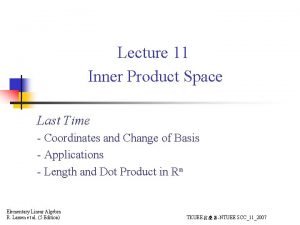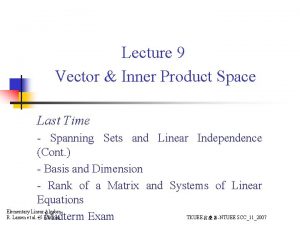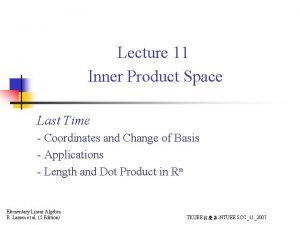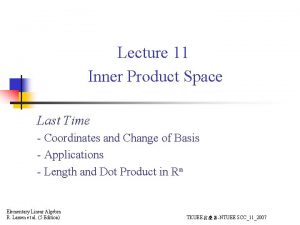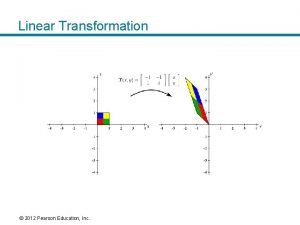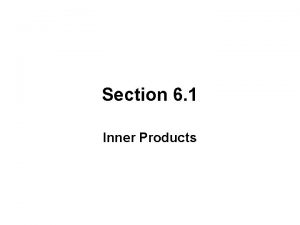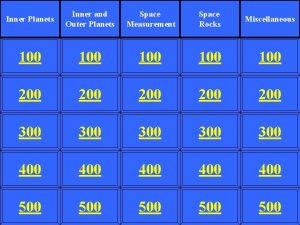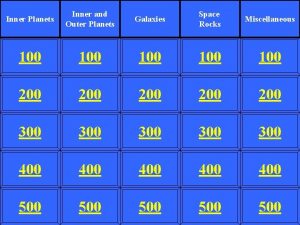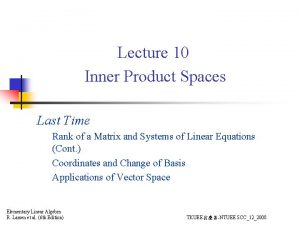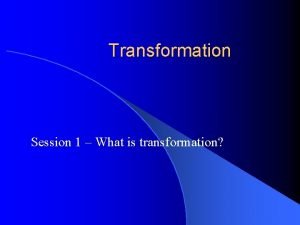Lecture 13 Inner Product Space Linear Transformation Last


















































- Slides: 50

Lecture 13 Inner Product Space & Linear Transformation Last Time - Orthonormal Bases: Gram-Schmidt Process - Mathematical Models and Least Square Analysis - Inner Product Space Applications Elementary Linear Algebra R. Larsen et al. (5 Edition) TKUEE翁慶昌-NTUEE SCC_12_2007

Lecture 12: Inner Product Spaces & L. T. Today n Mathematical Models and Least Square Analysis n Inner Product Space Applications n Introduction to Linear Transformations Reading Assignment: Secs 5. 4, 5. 5, 6. 1, 6. 2 Next Time n The Kernel and Range of a Linear Transformation n Matrices for Linear Transformations n Transition Matrix and Similarity Reading Assignment: Secs 6. 2 -6. 4 13 - 2

What Have You Actually Learned about Projection So Far? 13 - 3

5. 4 Mathematical Models and Least Squares Analysis n Orthogonal complement of W: Let W be a subspace of an inner product space V. (a) A vector u in V is said to orthogonal to W, if u is orthogonal to every vector in W. (b) The set of all vectors in V that are orthogonal to W is called the orthogonal complement of W. (read “ § Notes: 13 - 4 perp”)

n Direct sum: Let and be two subspaces of . If each vector can be uniquely written as a sum of a vector n and a vector from direct sum of and , , then , and you can write from is the. Thm 5. 13: (Properties of orthogonal subspaces) Let W be a subspace of Rn. Then the following properties are true. (1) (2) (3) 13 - 5

n Find by the other method: 13 - 6

n Thm 5. 16: (Fundamental subspaces of a matrix) If A is an m×n matrix, then (1) (2) (3) (4) 13 - 7

n Ex 6: (Fundamental subspaces) Find the four fundamental subspaces of the matrix. (reduced row-echelon form) Sol: 13 - 8

n Check: 13 - 9

n Ex 3: Let W is a subspace of R 4 and . (a) Find a basis for W (b) Find a basis for the orthogonal complement of W. Sol: (reduced row-echelon form) 13 - 10

is a basis for W n Notes: 13 - 11

Least Squares Problem n Least squares problem: (A system of linear equations) (1) When the system is consistent, we can use the Gaussian elimination with back-substitution to solve for x (2) When the system is consistent, how to find the “best possible” solution of the system. That is, the value of x for which the difference between Ax and b is small. 13 - 12

n Least squares solution: Given a system Ax = b of m linear equations in n unknowns, the least squares problem is to find a vector x in Rn that minimizes with respect to the Euclidean inner product on Rn. Such a vector is called a least squares solution of Ax = b. 13 - 13

(the normal system associated with Ax = b) 13 - 14

n Note: The problem of finding the least squares solution of is equal to he problem of finding an exact solution of the associated normal system n . Thm: For any linear system , the associated normal system is consistent, and all solutions of the normal system are least squares solution of Ax = b. Moreover, if W is the column space of A, and x is any least squares solution of Ax = b, then the orthogonal projection of b on W is 13 - 15

n Thm: If A is an m×n matrix with linearly independent column vectors, then for every m× 1 matrix b, the linear system Ax = b has a unique least squares solution. This solution is given by Moreover, if W is the column space of A, then the orthogonal projection of b on W is 13 - 16

n Ex 7: (Solving the normal equations) Find the least squares solution of the following system and find the orthogonal projection of b on the column space of A. 13 - 17

n Sol: the associated normal system 13 - 18

the least squares solution of Ax = b the orthogonal projection of b on the column space of A 13 - 19

Keywords in Section 5. 4: n orthogonal to W: 正交於W n orthogonal complement: 正交補集 n direct sum: 直和 n projection onto a subspace: 在子空間的投影 n fundamental subspaces: 基本子空間 n least squares problem: 最小平方問題 n normal equations: 一般方程式 13 - 20



Application: Cross Product Cross product (vector product) of two vectors 向量(vector) 方向: use right-hand rule The cross product is not commutative: The cross product is distributive: 13 - 23

Application: Cross Product Parallelogram representation of the vector product y Bsinθ Area θ x 13 - 24

向量之三重純量積 Triple Scalar product 純量(scalar) The dot and the cross may be interchanged : 13 - 25

向量之三重純量積 Parallelepiped representation of triple scalar product Volume of parallelepiped defined by z y x 13 - 26 , , and

Fourier Approximation 13 - 27

Fourier Approximation n n The Fourier series transforms a given periodic function into a superposition of sine and cosine waves The following equations are used 13 - 28

Today n Mathematical Models and Least Square Analysis (Cont. ) n Inner Product Space Applications n Introduction to Linear Transformations n The Kernel and Range of a Linear Transformation 12 - 29

6. 1 Introduction to Linear Transformations n Function T that maps a vector space V into a vector space W: V: the domain of T W: the codomain of T 13 - 30

n Image of v under T: If v is in V and w is in W such that Then w is called the image of v under T. n n the range of T: The set of all images of vectors in V. the preimage of w: The set of all v in V such that T(v)=w. 13 - 31

n Ex 1: (A function from R 2 into R 2 ) (a) Find the image of v=(-1, 2). (b) Find the preimage of w=(-1, 11) Sol: Thus {(3, 4)} is the preimage of w=(-1, 11). 13 - 32

n Linear Transformation (L. T. ): 13 - 31

n Notes: (1) A linear transformation is said to be operation preserving. Addition in V Addition in W Scalar multiplication in V Scalar multiplication in W (2) A linear transformation from a vector space into itself is called a linear operator. 13 - 34

n Ex 2: (Verifying a linear transformation T from R 2 into R 2) Pf: 13 - 35

Therefore, T is a linear transformation. 13 - 36

n Ex 3: (Functions that are not linear transformations) 13 - 37

n Notes: Two uses of the term “linear”. (1) is called a linear function because its graph is a line. (2) is not a linear transformation from a vector space R into R because it preserves neither vector addition nor scalar multiplication. 13 - 38

n Zero transformation: n Identity transformation: n Thm 6. 1: (Properties of linear transformations) 13 - 39

n Ex 4: (Linear transformations and bases) Let be a linear transformation such that Find T(2, 3, -2). Sol: (T is a L. T. ) 13 - 40

n Ex 5: (A linear transformation defined by a matrix) The function is defined as Sol: (vector addition) (scalar multiplication) 13 - 41

n Thm 6. 2: (The linear transformation given by a matrix) Let A be an m n matrix. The function T defined by is a linear transformation from Rn into Rm. n Note: 13 - 42

n Ex 7: (Rotation in the plane) Show that the L. T. given by the matrix has the property that it rotates every vector in R 2 counterclockwise about the origin through the angle . Sol: (polar coordinates) r: the length of v :the angle from the positive x-axis counterclockwise to the vector v 13 - 43

r:the length of T(v) + :the angle from the positive x-axis counterclockwise to the vector T(v) Thus, T(v) is the vector that results from rotating the vector v counterclockwise through the angle . 13 - 44

n Ex 8: (A projection in R 3) The linear transformation is given by is called a projection in R 3. 13 - 45

n Ex 9: (A linear transformation from Mm n into Mn m ) Show that T is a linear transformation. Sol: Therefore, T is a linear transformation from Mm n into Mn m. 13 - 46

Keywords in Section 6. 1: n function: 函數 n domain: 論域 n codomain: 對應論域 n image of v under T: 在T映射下v的像 n range of T: T的值域 n preimage of w: w的反像 n linear transformation: 線性轉換 n linear operator: 線性運算子 n zero transformation: 零轉換 n identity transformation: 相等轉換 13 - 47

Today n Mathematical Models and Least Square Analysis (Cont. ) n Inner Product Space Applications n Introduction to Linear Transformations n The Kernel and Range of a Linear Transformation 13 - 48

6. 2 The Kernel and Range of a Linear Transformation n Kernel of a linear transformation T: Let be a linear transformation Then the set of all vectors v in V that satisfy called the kernel of T and is denoted by ker(T). n Ex 1: (Finding the kernel of a linear transformation) Sol: 13 - 49 is

n Ex 2: (The kernel of the zero and identity transformations) (a) T(v)=0 (the zero transformation (b) T(v)=v (the identity transformation n ) ) Ex 3: (Finding the kernel of a linear transformation) Sol: 13 - 50
 Inner critic inner defender inner guide
Inner critic inner defender inner guide Inner product space definition
Inner product space definition Inner product space definition
Inner product space definition Inner product space definition
Inner product space definition Matrix vector space
Matrix vector space Dot cross product
Dot cross product Inner product in linear algebra
Inner product in linear algebra Inner critic and inner defender
Inner critic and inner defender Linearly dependent
Linearly dependent Linear algebra 1
Linear algebra 1 01:640:244 lecture notes - lecture 15: plat, idah, farad
01:640:244 lecture notes - lecture 15: plat, idah, farad Inner space caverns map
Inner space caverns map Inner product dirac notation
Inner product dirac notation What is euclidean inner product
What is euclidean inner product Orthonormal basis
Orthonormal basis Inner product length and orthogonality
Inner product length and orthogonality Randy pausch the last lecture summary
Randy pausch the last lecture summary Linear regression lecture
Linear regression lecture The transformation model operations management
The transformation model operations management Transformations of linear functions
Transformations of linear functions Linear transformation
Linear transformation Direct linear transformation camera calibration
Direct linear transformation camera calibration Contoh transformasi linear
Contoh transformasi linear Isomorphism 線性代數
Isomorphism 線性代數 Eigenspace
Eigenspace Linear transformation
Linear transformation Intensity transformation
Intensity transformation Linear transformation
Linear transformation Piecewise linear transformation in digital image processing
Piecewise linear transformation in digital image processing Isomorphism vector space
Isomorphism vector space Unscented trajectory chapter 5
Unscented trajectory chapter 5 Space junk the space age began
Space junk the space age began Camera space to world space
Camera space to world space Unscented trajectory chapter 5
Unscented trajectory chapter 5 World space to screen space
World space to screen space Product life cycle kotler
Product life cycle kotler Contoh produk gabungan
Contoh produk gabungan Marginal product and average product
Marginal product and average product Product mix and product line
Product mix and product line Core product augmented product
Core product augmented product Overall financial attractiveness of the proposed venture
Overall financial attractiveness of the proposed venture Product line depth
Product line depth Sifat perkalian cross vektor
Sifat perkalian cross vektor Actual product adalah
Actual product adalah Product portfolio mix
Product portfolio mix Hasil kali silang dua vektor
Hasil kali silang dua vektor Gdp vs gnp
Gdp vs gnp Synthetic division guided notes
Synthetic division guided notes Expanding the product of two linear expressions
Expanding the product of two linear expressions Simple and multiple linear regression
Simple and multiple linear regression Contoh persamaan non linear
Contoh persamaan non linear


